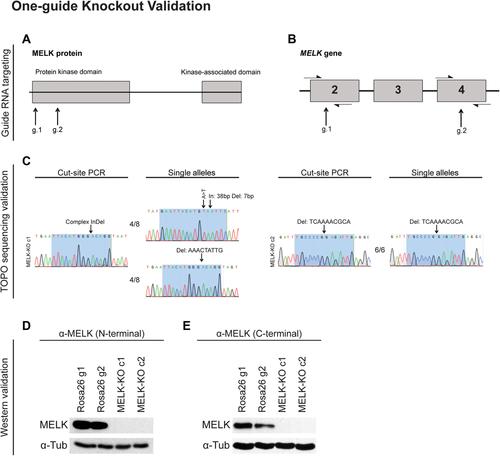{"title":"利用CRISPR/Cas9在哺乳动物细胞中产生单细胞来源的敲除克隆","authors":"Christopher J. Giuliano, Ann Lin, Vishruth Girish, Jason M. Sheltzer","doi":"10.1002/cpmb.100","DOIUrl":null,"url":null,"abstract":"CRISPR/Cas9 technology enables the rapid generation of loss‐of‐function mutations in a targeted gene in mammalian cells. A single cell harboring those mutations can be used to establish a new cell line, thereby creating a CRISPR‐induced knockout clone. These clonal cell lines serve as crucial tools for exploring protein function, analyzing the consequences of gene loss, and investigating the specificity of biological reagents. However, the successful derivation of knockout clones can be technically challenging and may be complicated by multiple factors, including incomplete target ablation and interclonal heterogeneity. Here, we describe optimized protocols and plasmids for generating clonal knockouts in mammalian cell lines. We provide strategies for guide RNA design, CRISPR delivery, and knockout validation that facilitate the derivation of true knockout clones and are amenable to multiplexed gene targeting. These protocols will be broadly useful for researchers seeking to apply CRISPR to study gene function in mammalian cells. © 2019 The Authors.","PeriodicalId":10734,"journal":{"name":"Current Protocols in Molecular Biology","volume":"128 1","pages":""},"PeriodicalIF":0.0000,"publicationDate":"2019-07-26","publicationTypes":"Journal Article","fieldsOfStudy":null,"isOpenAccess":false,"openAccessPdf":"https://sci-hub-pdf.com/10.1002/cpmb.100","citationCount":"65","resultStr":"{\"title\":\"Generating Single Cell–Derived Knockout Clones in Mammalian Cells with CRISPR/Cas9\",\"authors\":\"Christopher J. Giuliano, Ann Lin, Vishruth Girish, Jason M. Sheltzer\",\"doi\":\"10.1002/cpmb.100\",\"DOIUrl\":null,\"url\":null,\"abstract\":\"CRISPR/Cas9 technology enables the rapid generation of loss‐of‐function mutations in a targeted gene in mammalian cells. A single cell harboring those mutations can be used to establish a new cell line, thereby creating a CRISPR‐induced knockout clone. These clonal cell lines serve as crucial tools for exploring protein function, analyzing the consequences of gene loss, and investigating the specificity of biological reagents. However, the successful derivation of knockout clones can be technically challenging and may be complicated by multiple factors, including incomplete target ablation and interclonal heterogeneity. Here, we describe optimized protocols and plasmids for generating clonal knockouts in mammalian cell lines. We provide strategies for guide RNA design, CRISPR delivery, and knockout validation that facilitate the derivation of true knockout clones and are amenable to multiplexed gene targeting. These protocols will be broadly useful for researchers seeking to apply CRISPR to study gene function in mammalian cells. © 2019 The Authors.\",\"PeriodicalId\":10734,\"journal\":{\"name\":\"Current Protocols in Molecular Biology\",\"volume\":\"128 1\",\"pages\":\"\"},\"PeriodicalIF\":0.0000,\"publicationDate\":\"2019-07-26\",\"publicationTypes\":\"Journal Article\",\"fieldsOfStudy\":null,\"isOpenAccess\":false,\"openAccessPdf\":\"https://sci-hub-pdf.com/10.1002/cpmb.100\",\"citationCount\":\"65\",\"resultStr\":null,\"platform\":\"Semanticscholar\",\"paperid\":null,\"PeriodicalName\":\"Current Protocols in Molecular Biology\",\"FirstCategoryId\":\"1085\",\"ListUrlMain\":\"https://onlinelibrary.wiley.com/doi/10.1002/cpmb.100\",\"RegionNum\":0,\"RegionCategory\":null,\"ArticlePicture\":[],\"TitleCN\":null,\"AbstractTextCN\":null,\"PMCID\":null,\"EPubDate\":\"\",\"PubModel\":\"\",\"JCR\":\"Q2\",\"JCRName\":\"Biochemistry, Genetics and Molecular Biology\",\"Score\":null,\"Total\":0}","platform":"Semanticscholar","paperid":null,"PeriodicalName":"Current Protocols in Molecular Biology","FirstCategoryId":"1085","ListUrlMain":"https://onlinelibrary.wiley.com/doi/10.1002/cpmb.100","RegionNum":0,"RegionCategory":null,"ArticlePicture":[],"TitleCN":null,"AbstractTextCN":null,"PMCID":null,"EPubDate":"","PubModel":"","JCR":"Q2","JCRName":"Biochemistry, Genetics and Molecular Biology","Score":null,"Total":0}
引用次数: 65
Generating Single Cell–Derived Knockout Clones in Mammalian Cells with CRISPR/Cas9
CRISPR/Cas9 technology enables the rapid generation of loss‐of‐function mutations in a targeted gene in mammalian cells. A single cell harboring those mutations can be used to establish a new cell line, thereby creating a CRISPR‐induced knockout clone. These clonal cell lines serve as crucial tools for exploring protein function, analyzing the consequences of gene loss, and investigating the specificity of biological reagents. However, the successful derivation of knockout clones can be technically challenging and may be complicated by multiple factors, including incomplete target ablation and interclonal heterogeneity. Here, we describe optimized protocols and plasmids for generating clonal knockouts in mammalian cell lines. We provide strategies for guide RNA design, CRISPR delivery, and knockout validation that facilitate the derivation of true knockout clones and are amenable to multiplexed gene targeting. These protocols will be broadly useful for researchers seeking to apply CRISPR to study gene function in mammalian cells. © 2019 The Authors.



